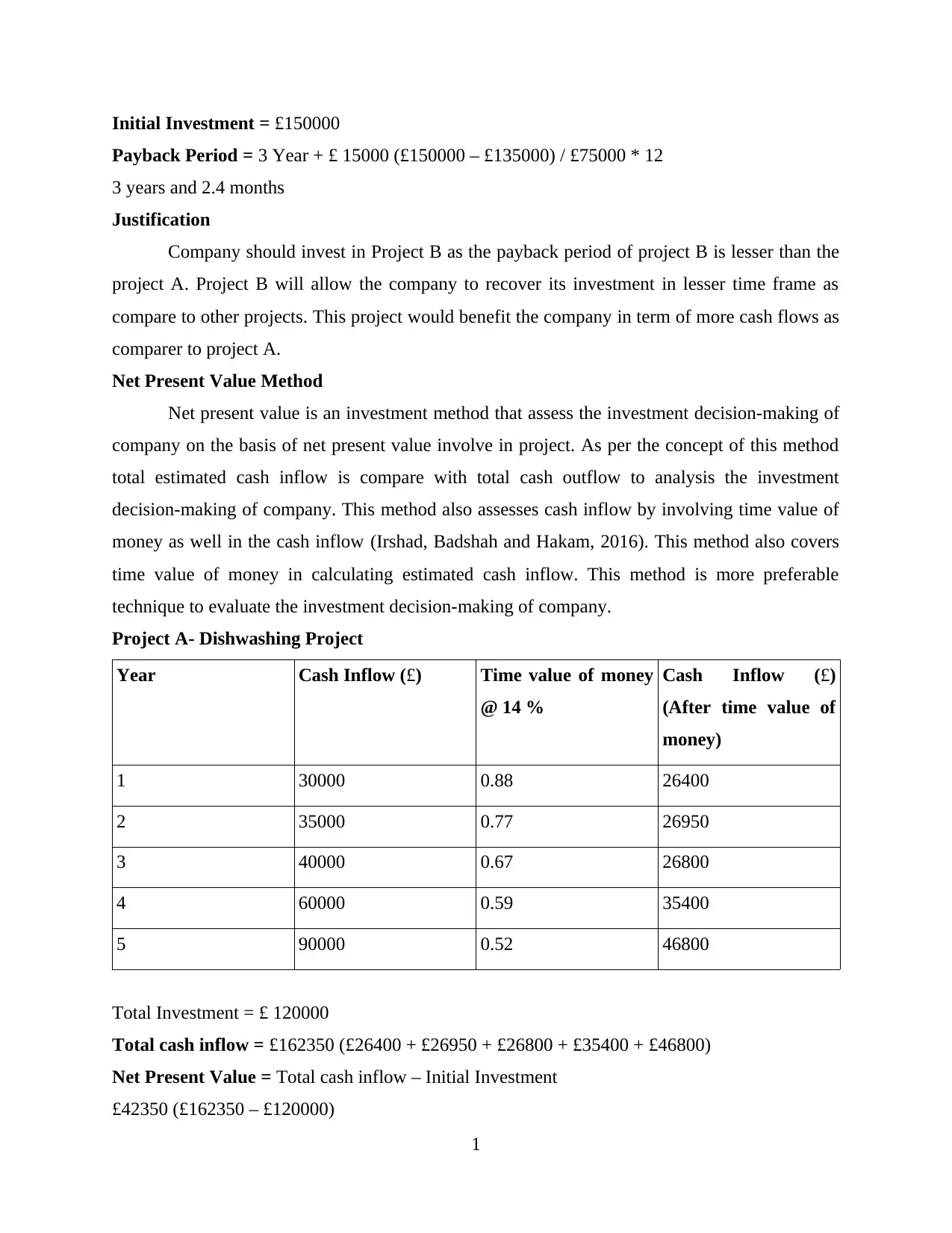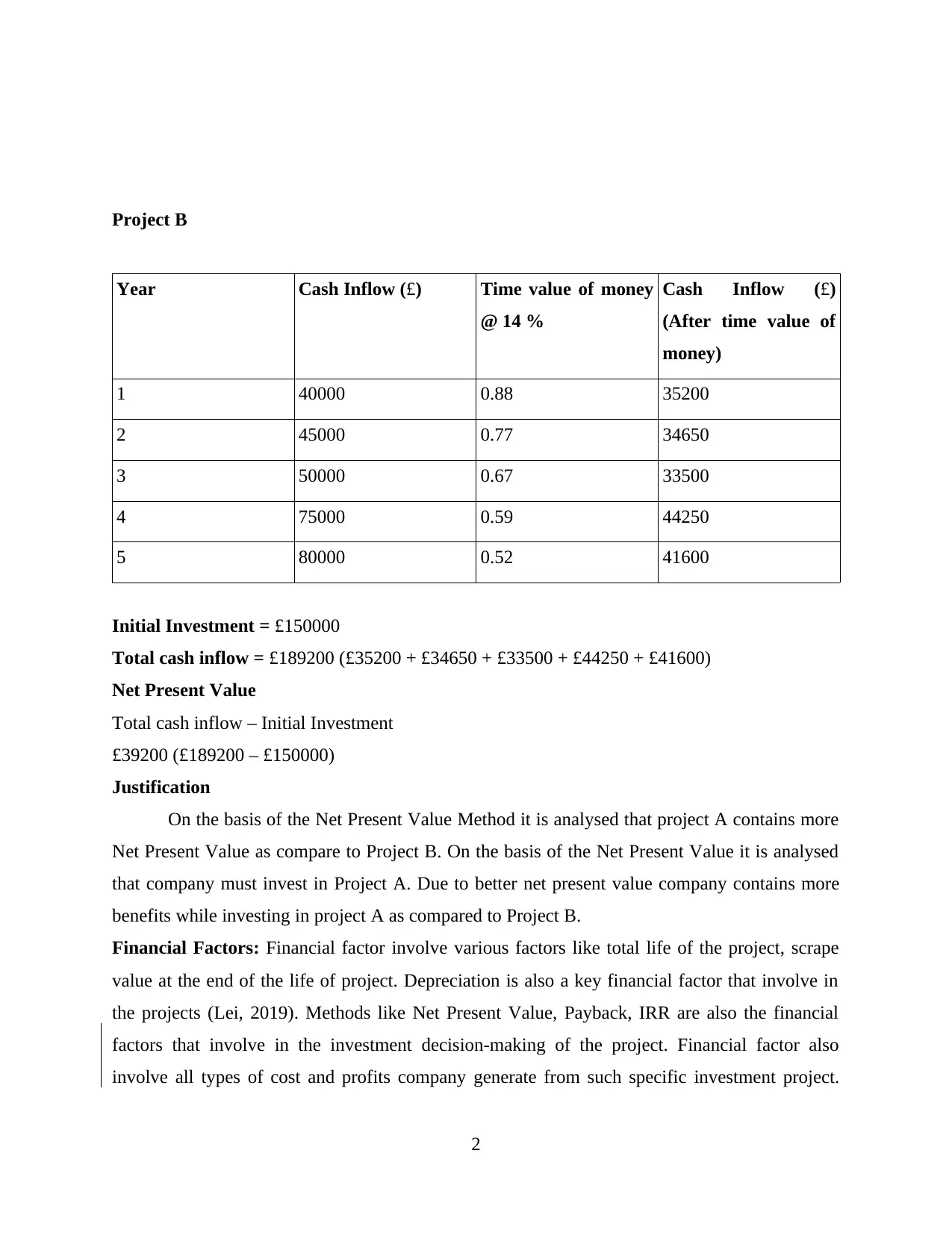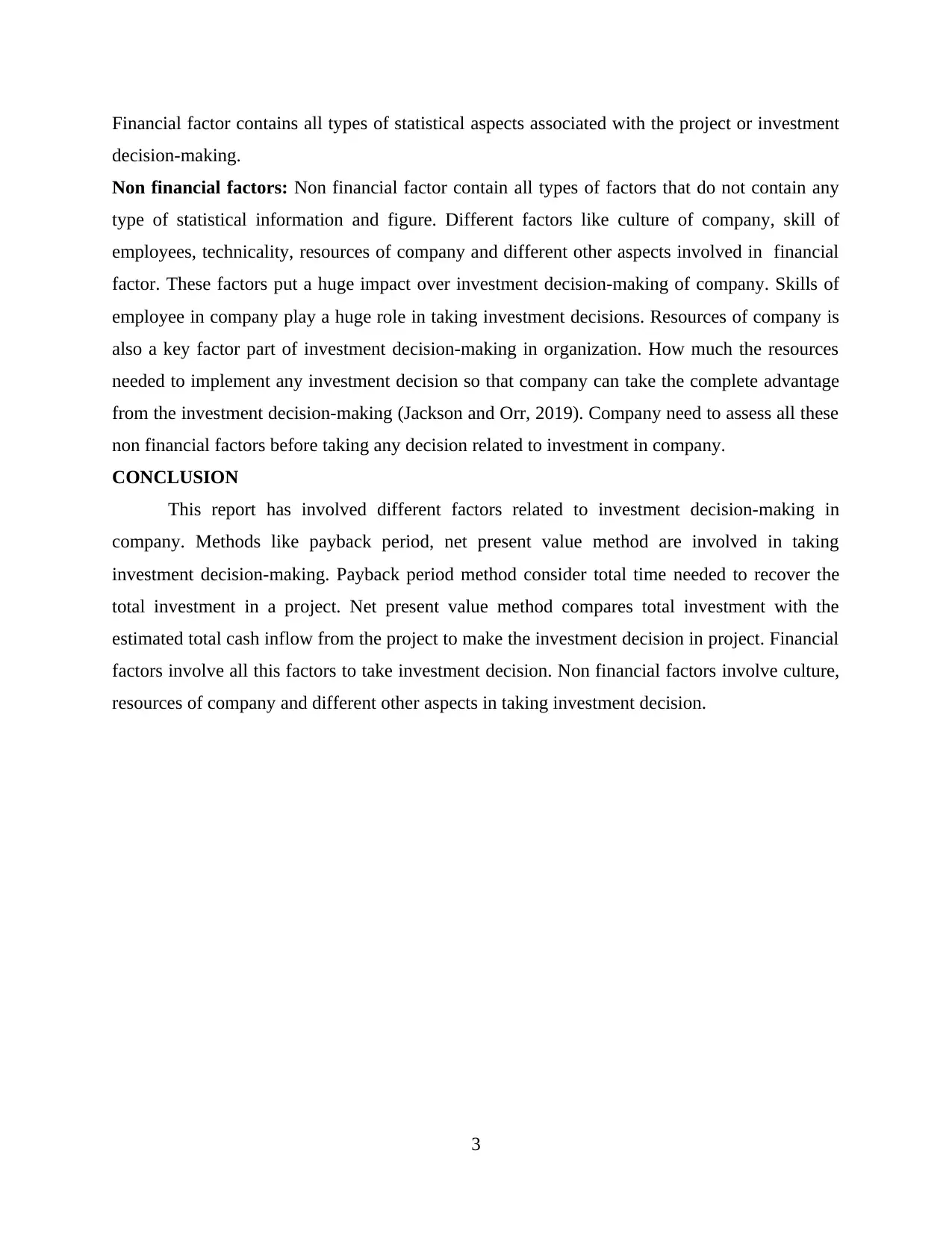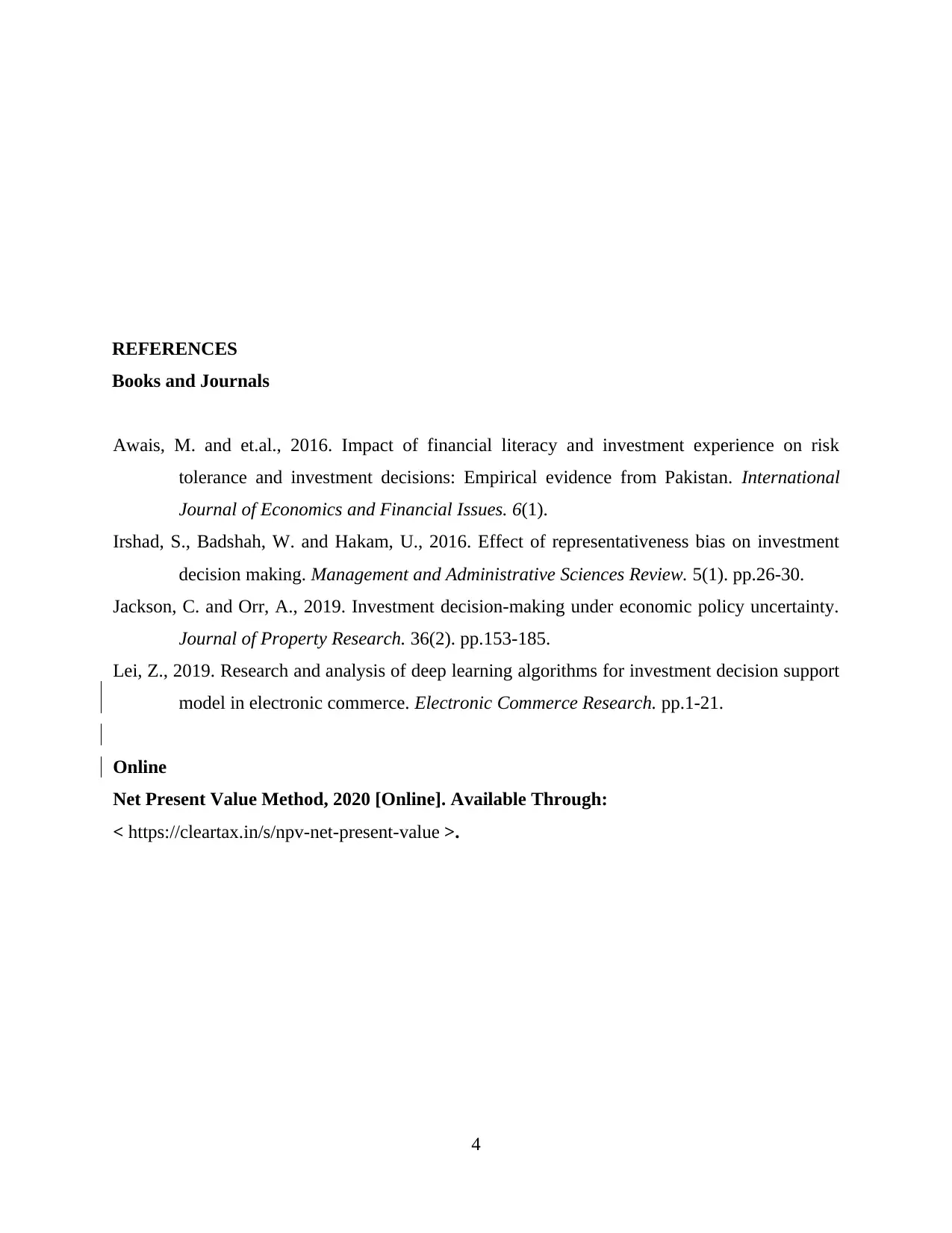Business Decision Making Essay: Project Investment Decision Analysis
VerifiedAdded on 2023/01/07
|8
|1323
|75
Essay
AI Summary
This essay examines business decision-making processes, specifically focusing on investment decisions within a company. It begins with an introduction to the core concepts of business decision-making, using a case study of A&B Plc, a restaurant chain in the United Kingdom. The main body of the essay explores investment decision-making through two primary methods: the payback period method and the net present value (NPV) method. The payback period method assesses the time required to recover an initial investment, while the NPV method considers the time value of money to evaluate the profitability of a project. The essay provides detailed calculations and justifications for each method, comparing project A and project B. Furthermore, the essay discusses financial and non-financial factors that influence investment decisions, including project lifespan, depreciation, company culture, employee skills, and available resources. The conclusion summarizes the key findings and emphasizes the importance of considering various factors when making investment choices. The essay also includes a list of references.

Bussines Decision Making
Paraphrase This Document
Need a fresh take? Get an instant paraphrase of this document with our AI Paraphraser

Table of Contents
INTRODUCTION...........................................................................................................................3
MAIN BODY...................................................................................................................................3
Investment decision-making........................................................................................................3
CONCLUSION................................................................................................................................3
REFERENCES................................................................................................................................4
INTRODUCTION...........................................................................................................................3
MAIN BODY...................................................................................................................................3
Investment decision-making........................................................................................................3
CONCLUSION................................................................................................................................3
REFERENCES................................................................................................................................4

INTRODUCTION
Business decision-making is all about assessment in respect to analysis about company
should invest in a particular project or not. This report is based on the case study of A&B Plc in
respect to its investment decision-making. The organisation is a restaurant chain operating its
business in United Kingdom. This report is an assessment of company in respect to its
investment in projects. Henceforth, report would assess the investment decision-making
company has made in its projects.
MAIN BODY
Investment decision-making
The payback period method
Payback period method is an investment decision method that make assessment in respect
to the investment decision making of company. This method involves projected cash outflow and
inflow in the investment decision. The estimated cash inflow is compared with the estimated
cash outflow to assess the investment decision of company. This method make investment
decision-making on the basis of the estimated time needed to recover the overall investment in
project (Awais and et.al., 2016). The project that contain the least payback period time would be
a preferable choice for investment in this project. By comparing the total cash flows with the
initial level of investment in the project payback period is calculated in this method.
Project A- Dishwashing Project
Year Cash Inflow (£) Accumulated Cash Inflow (£)
1 30000 30000
2 35000 65000 (30000 + 35000)
3 40000 105000 (30000 + 35000 +
40000)
4 60000 165000 (30000 + 35000 +
40000 + 60000)
5 90000 255000 (30000 + 35000 +
40000 + 60000 + 90000)
Initial Investment = £120000
Business decision-making is all about assessment in respect to analysis about company
should invest in a particular project or not. This report is based on the case study of A&B Plc in
respect to its investment decision-making. The organisation is a restaurant chain operating its
business in United Kingdom. This report is an assessment of company in respect to its
investment in projects. Henceforth, report would assess the investment decision-making
company has made in its projects.
MAIN BODY
Investment decision-making
The payback period method
Payback period method is an investment decision method that make assessment in respect
to the investment decision making of company. This method involves projected cash outflow and
inflow in the investment decision. The estimated cash inflow is compared with the estimated
cash outflow to assess the investment decision of company. This method make investment
decision-making on the basis of the estimated time needed to recover the overall investment in
project (Awais and et.al., 2016). The project that contain the least payback period time would be
a preferable choice for investment in this project. By comparing the total cash flows with the
initial level of investment in the project payback period is calculated in this method.
Project A- Dishwashing Project
Year Cash Inflow (£) Accumulated Cash Inflow (£)
1 30000 30000
2 35000 65000 (30000 + 35000)
3 40000 105000 (30000 + 35000 +
40000)
4 60000 165000 (30000 + 35000 +
40000 + 60000)
5 90000 255000 (30000 + 35000 +
40000 + 60000 + 90000)
Initial Investment = £120000
⊘ This is a preview!⊘
Do you want full access?
Subscribe today to unlock all pages.

Trusted by 1+ million students worldwide

Payback Period= 3 year + £ 15000 (£ 120000 - £ 105000)/£ 60000 * 12
3 year and 3 months.
Project B
Year Cash Inflow (£) Accumulated Cash Inflow (£)
1 40000 40000
2 45000 85000 (40000 + 45000)
3 50000 135000 ( 40000 + 45000 +
50000)
4 75000 210000 ( 40000 + 45000 +
50000 + 75000)
5 80000 290000 ( 40000 + 45000 +
50000 + 75000 + 80000)
3 year and 3 months.
Project B
Year Cash Inflow (£) Accumulated Cash Inflow (£)
1 40000 40000
2 45000 85000 (40000 + 45000)
3 50000 135000 ( 40000 + 45000 +
50000)
4 75000 210000 ( 40000 + 45000 +
50000 + 75000)
5 80000 290000 ( 40000 + 45000 +
50000 + 75000 + 80000)
Paraphrase This Document
Need a fresh take? Get an instant paraphrase of this document with our AI Paraphraser

Initial Investment = £150000
Payback Period = 3 Year + £ 15000 (£150000 – £135000) / £75000 * 12
3 years and 2.4 months
Justification
Company should invest in Project B as the payback period of project B is lesser than the
project A. Project B will allow the company to recover its investment in lesser time frame as
compare to other projects. This project would benefit the company in term of more cash flows as
comparer to project A.
Net Present Value Method
Net present value is an investment method that assess the investment decision-making of
company on the basis of net present value involve in project. As per the concept of this method
total estimated cash inflow is compare with total cash outflow to analysis the investment
decision-making of company. This method also assesses cash inflow by involving time value of
money as well in the cash inflow (Irshad, Badshah and Hakam, 2016). This method also covers
time value of money in calculating estimated cash inflow. This method is more preferable
technique to evaluate the investment decision-making of company.
Project A- Dishwashing Project
Year Cash Inflow (£) Time value of money
@ 14 %
Cash Inflow (£)
(After time value of
money)
1 30000 0.88 26400
2 35000 0.77 26950
3 40000 0.67 26800
4 60000 0.59 35400
5 90000 0.52 46800
Total Investment = £ 120000
Total cash inflow = £162350 (£26400 + £26950 + £26800 + £35400 + £46800)
Net Present Value = Total cash inflow – Initial Investment
£42350 (£162350 – £120000)
1
Payback Period = 3 Year + £ 15000 (£150000 – £135000) / £75000 * 12
3 years and 2.4 months
Justification
Company should invest in Project B as the payback period of project B is lesser than the
project A. Project B will allow the company to recover its investment in lesser time frame as
compare to other projects. This project would benefit the company in term of more cash flows as
comparer to project A.
Net Present Value Method
Net present value is an investment method that assess the investment decision-making of
company on the basis of net present value involve in project. As per the concept of this method
total estimated cash inflow is compare with total cash outflow to analysis the investment
decision-making of company. This method also assesses cash inflow by involving time value of
money as well in the cash inflow (Irshad, Badshah and Hakam, 2016). This method also covers
time value of money in calculating estimated cash inflow. This method is more preferable
technique to evaluate the investment decision-making of company.
Project A- Dishwashing Project
Year Cash Inflow (£) Time value of money
@ 14 %
Cash Inflow (£)
(After time value of
money)
1 30000 0.88 26400
2 35000 0.77 26950
3 40000 0.67 26800
4 60000 0.59 35400
5 90000 0.52 46800
Total Investment = £ 120000
Total cash inflow = £162350 (£26400 + £26950 + £26800 + £35400 + £46800)
Net Present Value = Total cash inflow – Initial Investment
£42350 (£162350 – £120000)
1

Project B
Year Cash Inflow (£) Time value of money
@ 14 %
Cash Inflow (£)
(After time value of
money)
1 40000 0.88 35200
2 45000 0.77 34650
3 50000 0.67 33500
4 75000 0.59 44250
5 80000 0.52 41600
Initial Investment = £150000
Total cash inflow = £189200 (£35200 + £34650 + £33500 + £44250 + £41600)
Net Present Value
Total cash inflow – Initial Investment
£39200 (£189200 – £150000)
Justification
On the basis of the Net Present Value Method it is analysed that project A contains more
Net Present Value as compare to Project B. On the basis of the Net Present Value it is analysed
that company must invest in Project A. Due to better net present value company contains more
benefits while investing in project A as compared to Project B.
Financial Factors: Financial factor involve various factors like total life of the project, scrape
value at the end of the life of project. Depreciation is also a key financial factor that involve in
the projects (Lei, 2019). Methods like Net Present Value, Payback, IRR are also the financial
factors that involve in the investment decision-making of the project. Financial factor also
involve all types of cost and profits company generate from such specific investment project.
2
Year Cash Inflow (£) Time value of money
@ 14 %
Cash Inflow (£)
(After time value of
money)
1 40000 0.88 35200
2 45000 0.77 34650
3 50000 0.67 33500
4 75000 0.59 44250
5 80000 0.52 41600
Initial Investment = £150000
Total cash inflow = £189200 (£35200 + £34650 + £33500 + £44250 + £41600)
Net Present Value
Total cash inflow – Initial Investment
£39200 (£189200 – £150000)
Justification
On the basis of the Net Present Value Method it is analysed that project A contains more
Net Present Value as compare to Project B. On the basis of the Net Present Value it is analysed
that company must invest in Project A. Due to better net present value company contains more
benefits while investing in project A as compared to Project B.
Financial Factors: Financial factor involve various factors like total life of the project, scrape
value at the end of the life of project. Depreciation is also a key financial factor that involve in
the projects (Lei, 2019). Methods like Net Present Value, Payback, IRR are also the financial
factors that involve in the investment decision-making of the project. Financial factor also
involve all types of cost and profits company generate from such specific investment project.
2
⊘ This is a preview!⊘
Do you want full access?
Subscribe today to unlock all pages.

Trusted by 1+ million students worldwide

Financial factor contains all types of statistical aspects associated with the project or investment
decision-making.
Non financial factors: Non financial factor contain all types of factors that do not contain any
type of statistical information and figure. Different factors like culture of company, skill of
employees, technicality, resources of company and different other aspects involved in financial
factor. These factors put a huge impact over investment decision-making of company. Skills of
employee in company play a huge role in taking investment decisions. Resources of company is
also a key factor part of investment decision-making in organization. How much the resources
needed to implement any investment decision so that company can take the complete advantage
from the investment decision-making (Jackson and Orr, 2019). Company need to assess all these
non financial factors before taking any decision related to investment in company.
CONCLUSION
This report has involved different factors related to investment decision-making in
company. Methods like payback period, net present value method are involved in taking
investment decision-making. Payback period method consider total time needed to recover the
total investment in a project. Net present value method compares total investment with the
estimated total cash inflow from the project to make the investment decision in project. Financial
factors involve all this factors to take investment decision. Non financial factors involve culture,
resources of company and different other aspects in taking investment decision.
3
decision-making.
Non financial factors: Non financial factor contain all types of factors that do not contain any
type of statistical information and figure. Different factors like culture of company, skill of
employees, technicality, resources of company and different other aspects involved in financial
factor. These factors put a huge impact over investment decision-making of company. Skills of
employee in company play a huge role in taking investment decisions. Resources of company is
also a key factor part of investment decision-making in organization. How much the resources
needed to implement any investment decision so that company can take the complete advantage
from the investment decision-making (Jackson and Orr, 2019). Company need to assess all these
non financial factors before taking any decision related to investment in company.
CONCLUSION
This report has involved different factors related to investment decision-making in
company. Methods like payback period, net present value method are involved in taking
investment decision-making. Payback period method consider total time needed to recover the
total investment in a project. Net present value method compares total investment with the
estimated total cash inflow from the project to make the investment decision in project. Financial
factors involve all this factors to take investment decision. Non financial factors involve culture,
resources of company and different other aspects in taking investment decision.
3
Paraphrase This Document
Need a fresh take? Get an instant paraphrase of this document with our AI Paraphraser

REFERENCES
Books and Journals
Awais, M. and et.al., 2016. Impact of financial literacy and investment experience on risk
tolerance and investment decisions: Empirical evidence from Pakistan. International
Journal of Economics and Financial Issues. 6(1).
Irshad, S., Badshah, W. and Hakam, U., 2016. Effect of representativeness bias on investment
decision making. Management and Administrative Sciences Review. 5(1). pp.26-30.
Jackson, C. and Orr, A., 2019. Investment decision-making under economic policy uncertainty.
Journal of Property Research. 36(2). pp.153-185.
Lei, Z., 2019. Research and analysis of deep learning algorithms for investment decision support
model in electronic commerce. Electronic Commerce Research. pp.1-21.
Online
Net Present Value Method, 2020 [Online]. Available Through:
< https://cleartax.in/s/npv-net-present-value >.
4
Books and Journals
Awais, M. and et.al., 2016. Impact of financial literacy and investment experience on risk
tolerance and investment decisions: Empirical evidence from Pakistan. International
Journal of Economics and Financial Issues. 6(1).
Irshad, S., Badshah, W. and Hakam, U., 2016. Effect of representativeness bias on investment
decision making. Management and Administrative Sciences Review. 5(1). pp.26-30.
Jackson, C. and Orr, A., 2019. Investment decision-making under economic policy uncertainty.
Journal of Property Research. 36(2). pp.153-185.
Lei, Z., 2019. Research and analysis of deep learning algorithms for investment decision support
model in electronic commerce. Electronic Commerce Research. pp.1-21.
Online
Net Present Value Method, 2020 [Online]. Available Through:
< https://cleartax.in/s/npv-net-present-value >.
4
1 out of 8
Related Documents
Your All-in-One AI-Powered Toolkit for Academic Success.
+13062052269
info@desklib.com
Available 24*7 on WhatsApp / Email
![[object Object]](/_next/static/media/star-bottom.7253800d.svg)
Unlock your academic potential
Copyright © 2020–2025 A2Z Services. All Rights Reserved. Developed and managed by ZUCOL.





